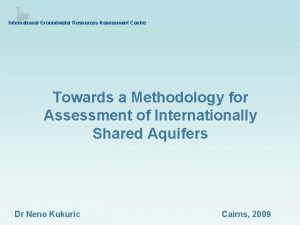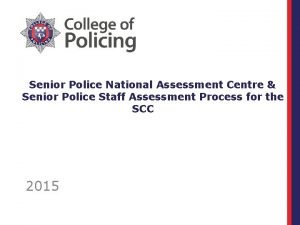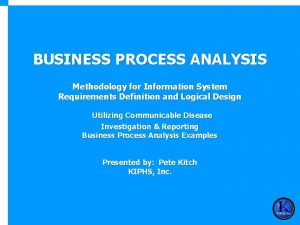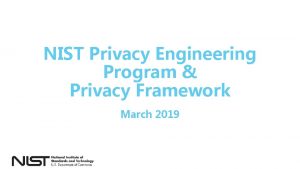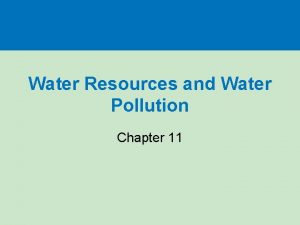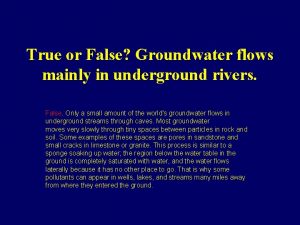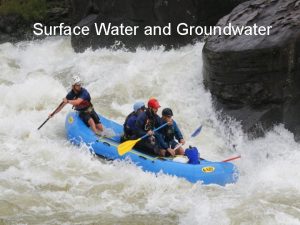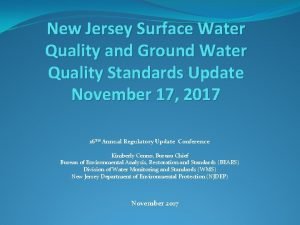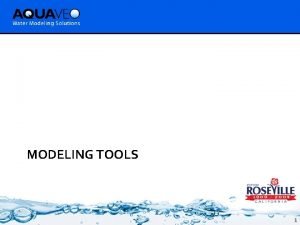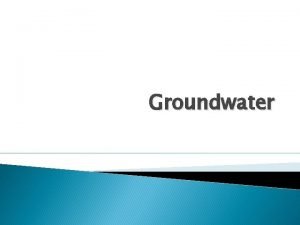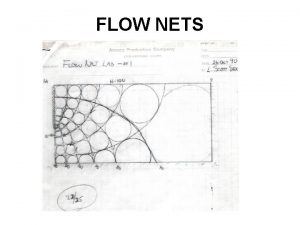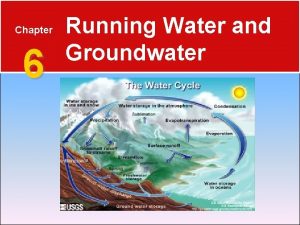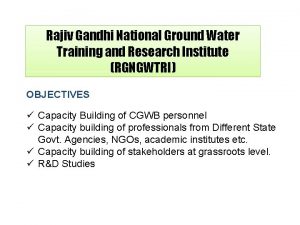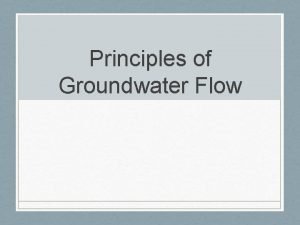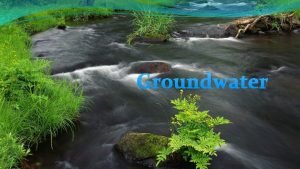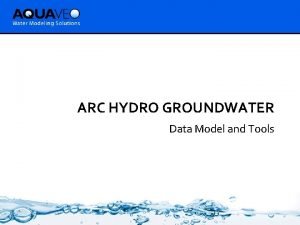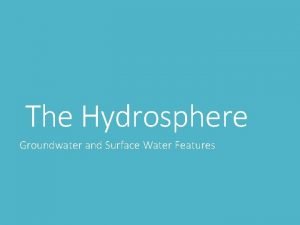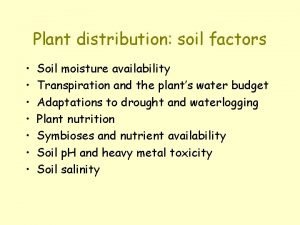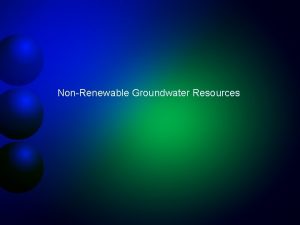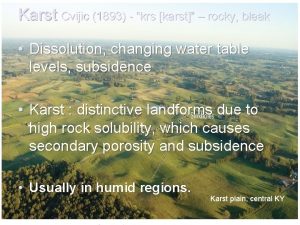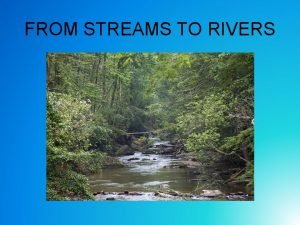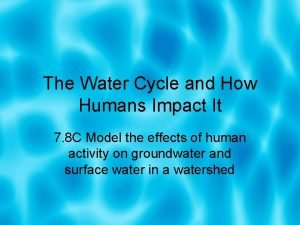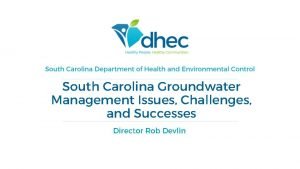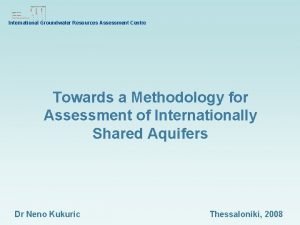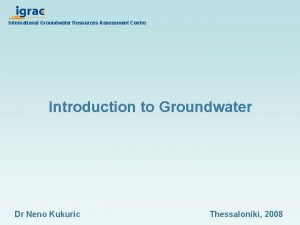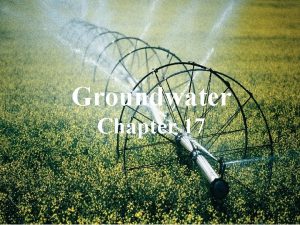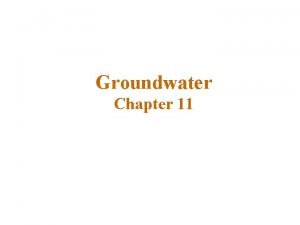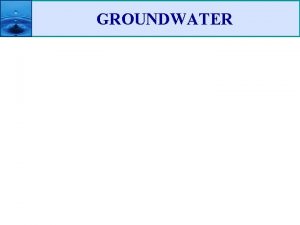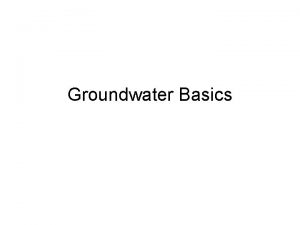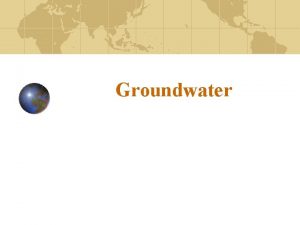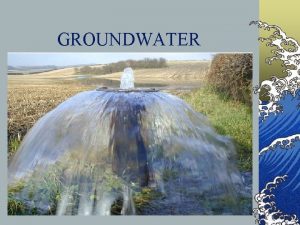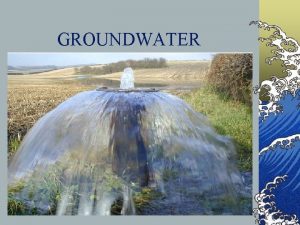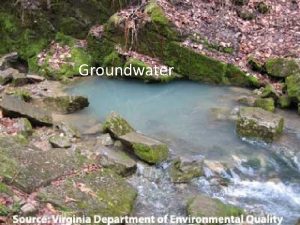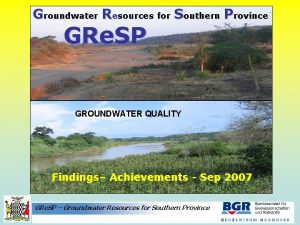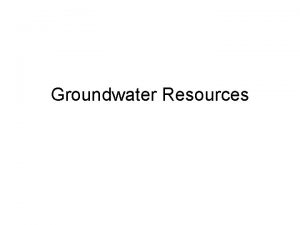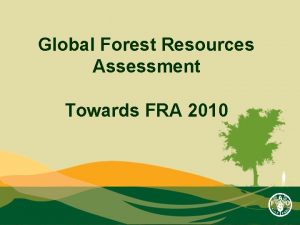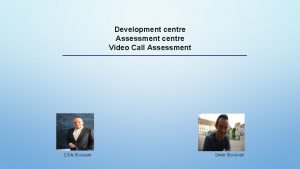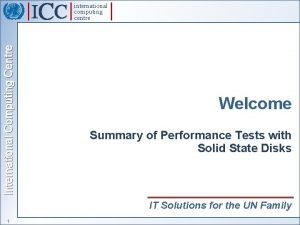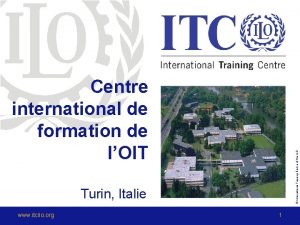International Groundwater Resources Assessment Centre Towards a Methodology































- Slides: 31

International Groundwater Resources Assessment Centre Towards a Methodology for Assessment of Internationally Shared Aquifers Dr Neno Kukuric Cairns, 2009

What is IGRAC? l l l IGRAC - International Groundwater Resource Assessment Centre is an UNESCO and WMO groundwater centre IGRAC facilitates and promotes global sharing of information and knowledge required for sustainable groundwater resources development and management. Focused on information and knowledge management, transboundary aquifer assessment and groundwater monitoring Receives financial support from the government of The Netherlands Hosted by the DELTARES in Utrecht, The Netherlands.

IGRAC Portal www. igrac. net

TBA Activities at IGRAC l A map Transboundary Aquifers of the World l ISARM Portal (www. isarm. net) l UN ILC assistance: International Legal Agreement on groundwater l TBA Methodology and a Course l GEF (Global Environment Facility) projects l ISARM Regional Activities l (cooperation with OAS, SADC, INWEB, UNECE, OOS, GWP-MED, GEF, UNEP, UNDP. . ).

A Map: TBAs of the World l l l Prepared as a Special Edition for the Fifth World Water Forum (Istanbul, March 2009) Shows the present state of information regarding the occurrence and extent of TBAs world-wide. The intention of the map is to provide a global overview of these important shared water resources and to encourage their further assessment.

TBAs of the World: Details

TBAs of the World (reverse side) assessment methodology procedure metadata references examples

ISARM Programme l l The worldwide ISARM (Internationally Shared Aquifer Resources Management) Initiative is an UNESCO led multiagency effort aimed at improving the understanding of hydrogeological, socio-economic, legal, institutional and environmental issues related to the management of transboundary aquifers. Since its start in 2002, ISARM has launched a number of regional initiatives designed to assess transboundary aquifer systems and to encourage riparian states to work cooperatively toward mutually beneficial and sustainable aquifer development.

Global Overview of ISARM activities Hydrogeological assessment of transboundary aquifers

ISARM Portal www. isarm. net

Regional ISARM activities A s a ic r e m

Regional ISARM activities f A a c ri

Regional ISARM activities A a i s

Transboundary Aquifers Assessment l Transboundary aquifer or transboundary aquifer system means, respectively, an aquifer or aquifer system, parts of which are situated in different States;

Transboundary Aquifers Assessment l l l The fact: many aquifers cross the political borders Potential cross-boundary problems: changes in groundwater flows, levels, volumes (quantity) and dissolved substances (quality). Actions: TBA characterisation and an appropriate management. l Benefits: eliminating potential sources of conflict and improving the overall benefit from groundwater.

TBA Assessment Rationale l l What does a TBA assessment encompass? ISARM programme: hydrological, legal, socio-economical, institutional and ecological aspects/facets of TBAs and suggested guidelines In practice, mostly a hydrogeological assessment (to incorporate info on other aspects as well) Clear need for general guidelines (as a procedure based on facts and structured experience from elsewhere) in order to enhance and alleviate a TBA assessment

TBA assessment steps l Delineation and description Classification, diagnostic analysis and zoning Data harmonisation and information management l Delineation and description l l l Classification, diagnostic analysis and zoning l l “inventory” or “characterisation” (stage and scale dependent) chiefly about collecting, combining and interpreting the field information necessary for decision-making (problems, opportunities, most responsive aquifers and aquifer zones) Data harmonisation and information management l Extra dimension in an international context (more difficult, more elaborated and politically sensitive)

Delineation and Description l l chiefly about collecting, combining and interpreting the field information “inventory” or “characterisation” (stage and scale dependent)

Standardised TBA Delineation (TBA Activities Americas)

Standardised TBA Delineation Tested in the Atlas of transboundary aquifers of Americas

Delineation and Description l A TDA description should a. o. include info recharge/discharge mechanism and hydraulic properties of aquifer to l l determine direction and velocity of groundwater flow and its interaction with other water bodies (rivers, lakes, seas). to assess aquifer’s vulnerability to overexploitation and pollution. Superimposed on these hydrogeological characteristics are the anthropogenic influences such as abstraction and pollution from various sources. ISARM and EU ECE TBA inventories vary substantially in their content UN ECE Facts & Figures: l Water uses l Pressure factors l Problems related to gw quality l Groundwater mngm. measures l Status l Future trends

Standardised TBA Description (TBA Activities Americas) ◄ Physiography, Demography & Water Use ◄ Geological Setting of Aquifer ◄ Water Quantity & Quality ◄ Importance and need for TBA ◄ TBA cooperation ◄ References ◄ Authors

Classification, Diagnostics and Zoning

Classification, Diagnostics and Zoning l Input for classification: l l l aquifer size and hydraulic properties, vulnerability, current functions, observed or perceived stresses, Possible groundwater interferences, etc. Input for diagnostics: l l l inventory of major perceived issues and problems; overview of possible actions Priority and feasibility study, stakeholders and institutional analysis.

Classification, Diagnostics and Zoning 2 1 Country A Country B 0 l l 250 km Activities at location 2 in country B will be much less risky for the aquifer in country A than activities at location 1 Effects resulting from causes at larger distance will be smaller and come with more retardation General flow direction does matter Zoning: e. g. based on isochrones of propagation of the effects (may contribute to a realistic picture of the transboundary risks).

Classification, Diagnostics and Zoning I 1 II Country A l l l II 2 Country B 0 l III 250 km Activities at location 2 in country B will be much less risky for the aquifer in country A than activities at location 1 Effects resulting from causes at larger distance will be smaller and come with more retardation General flow direction does matter Zoning: e. g. based on isochrones of propagation of the effects (may contribute to a realistic picture of the transboundary risks).

Harmonisation & Info management l Rationale l l l Technical activity l l l Assessment: availability and quality of data Internationally – also data harmonisation & info management Basically harmonisation of formats, classifications, terminologies, reference systems, levels, software and hardware specific, etc. Heavily influenced by political, organisational, legal, cultural and economical situation and agenda Objectives l Depend on scope and scale: visualisation, textual/spatial/temporal data, web-based, common processing, real-time

Harmonisation & Info management l Current situation l l l Mainly simple GIS- based databases (GEF projects) Developed databases or systems are (according to the available information) neither web-based, nor real-time Databases available via IGRAC and INWEB portals contain meta information on transboundary aquifers. No cases have been reported of harmonisation going beyond items such as reference levels and measurement scales. WISE accommodates delineated ‘groundwater bodies’, no observations are available yet Ideally, on-line synchronised access to distributed information services (data and information remain at the source!


Harmonisation & Info management

Concluding notes l Challenges of TBA assessment l l Need for a generally accepted TBA assessment methodology l l l (invisible groundwater, usually slow changes, various approaches to aquifer assessment, lack of information, political will…) Enhancing the assessment Improving information consistency Providing clear info for decision makers (on issues at stake, promising TBA management strategies and zones for TBA management actions) Importance of ISARM umbrella and cooperation with similar programmes and international projects (IWRM!) Thank you for your attention! United Nations Educational, Scientific and Cultural Organization World Meteorological Organization Government of The Netherlands Deltares
 Groundwater assessment methodology
Groundwater assessment methodology Centroid engineering mechanics
Centroid engineering mechanics Centroids and center of gravity
Centroids and center of gravity Transformed and transforming resources
Transformed and transforming resources Variable resources definition
Variable resources definition Renewable resources vs nonrenewable resources
Renewable resources vs nonrenewable resources National assessment centre police
National assessment centre police Business process assessment methodology
Business process assessment methodology Privacy engineering framework
Privacy engineering framework Ground water pollution
Ground water pollution How to overcome water pollution
How to overcome water pollution True or false: groundwater can flow.
True or false: groundwater can flow. Running water and groundwater
Running water and groundwater Nj groundwater quality standards
Nj groundwater quality standards Gms groundwater
Gms groundwater Groundwater label
Groundwater label Septic tank contamination groundwater
Septic tank contamination groundwater Groundwater flow net
Groundwater flow net Water erosion and deposition
Water erosion and deposition Chapter 6 running water and groundwater
Chapter 6 running water and groundwater The water cycle brainpop
The water cycle brainpop Rgngwtri
Rgngwtri Total head equation
Total head equation Permeability of rocks
Permeability of rocks Arc hydro groundwater
Arc hydro groundwater Water permeable
Water permeable Lenticels
Lenticels Why is groundwater a nonrenewable resource
Why is groundwater a nonrenewable resource Karst topography diagram
Karst topography diagram How does groundwater rejoin the water cycle
How does groundwater rejoin the water cycle Human impact on groundwater
Human impact on groundwater Groundwater
Groundwater
